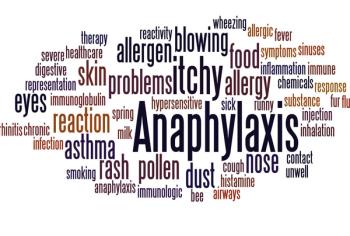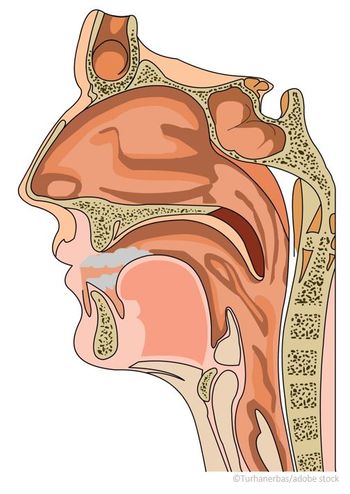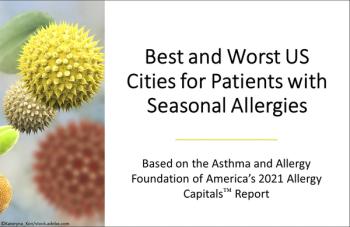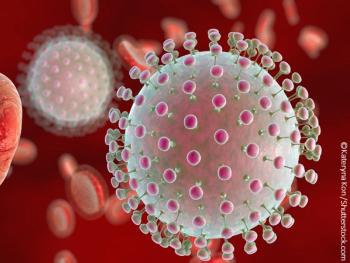
AAAAI: Seasonal Allergy Patients Also Bugged by Non-Allergic Irritants
SAN DIEGO -- Nearly half of all patients with seasonal allergies cite symptoms that can be triggered by non-allergic irritants, many of them linked to indoor air quality problems.
SAN DIEGO, March 1 -- Nearly half of all patients with seasonal allergies cite symptoms that can be triggered by non-allergic irritants, many of them are linked to indoor air quality problems, investigators here reported.
Many of the non-allergic irritants irritants are cited as risk factors for indoor air quality problems, also known as "sick building syndrome," noted Dennis Shusterman, M.D., M.P.H., of the University of Washington in Seattle.
"We frequently see patients in our clinic who complain of reactivity to workplace irritants, and/or problems with indoor air quality, and one of the premises I have in my work is that what allergists call non-allergic rhinitis very much overlaps with what the occupational medicine physician calls irritant rhinitis, and the two professions can learn from one another," Dr. Shusterman said.
In an analysis of data from a study he collected when he was at the University of California San Francisco, Dr. Shusterman and Mary Alice Murphy, M.D., an allergist, looked at 60 men and women from the ages of 18 to 69.
The participants were stratified by gender and seasonal allergy status into three age groups: 18 to 34, 35 to 51, and 52 to 69. One of the questions asked of the participants on the study questionnaire was what non-allergic triggers bothered them.
"We weren't looking at non-allergic rhinitics as defined by their reactivity to non-specific and chemical factors such as cold dry air, perfumes and colognes, cleaning products, environmental tobacco smoke, and so on," Dr. Shusterman said. "We were looking at allergic rhinitics and asking whether they also respond to these non-allergic triggers."
The participants' responses on non-allergic nasal symptom triggers were recorded on a scale from 0 to 8 (none to worst).
Specifically, they were asked whether they had a runny nose or congestion when they were eating hot or spicy foods, exposed to bright lights, used household cleaning products, smelled strong perfumes/cologne/aftershave, experienced sudden changes in air temperature or humidity, exercised, drank alcohol, or entered a smoky room.
The investigators found that 42% of those studied reported more than three non-allergic triggers, compared with only 3% of controls (P<0.01), a figure similar to that found in two other published studies.
"I think this is a real phenomenon in which there's a subset of allergic rhinitics who are also responsive to non-allergic triggers," Dr. Shusterman said.
The most frequent trigger was rhinorrhea in reaction to hot and spicy foods, experienced equally by both rhinitics and non-rhinitics. This finding was not surprising, in that getting a runny nose in response to incendiary cuisine is highly prevalent among both non-allergic and allergic people, he noted.
But for all other measures -- temperature/humidity, tobacco smoke, exercise, cleaning products, perfumes, alcohol, and bright lights -- the participants with seasonal allergies were much more likely to experience symptoms than non-rhinitics.
Participants older than 35 were more likely to report one or more irritants, particularly tobacco smoke (P<0.05), but there were no significant differences by gender in overall scores or specific symptom triggers.
Dr. Shusterman said that although it's not known why people with allergic rhinitis may also have non-allergic nasal hyperreactivity, clinicians who manage patients with allergic rhinitis should ask them about possible non-allergic triggers. In addition, clinical trials of drugs and environmental controls for allergic rhinitis need to take into account that symptoms can be triggered by both allergic and non-allergic factors.
The findings also suggest that employees with occupational allergies may become less reactive to occupational exposure if they are treated for their previously untreated perennial allergic rhinitis, Dr. Shusterman said.
Newsletter
Enhance your clinical practice with the Patient Care newsletter, offering the latest evidence-based guidelines, diagnostic insights, and treatment strategies for primary care physicians.































































































































































































































































































































